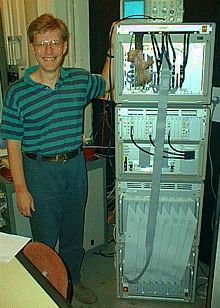Starpoint Adaptive Optics
The ELECTRA Project
|
The University of Durham's
Astronomical Instrumentation Group
developed a major astronomical adaptive optics instrument in the
mid-1990s – ELECTRA. The instrument operated at the "GHRIL"
Nasmyth platform of the UK's 4.2m
William Herschel Telescope
on La Palma in the Canary Islands. The adaptive mirror was of the
segmented variety, 76 square segments, each with three degrees of freedom
(tip; tilt; piston).
|
|
|
ELECTRA was the first operational AO system to use strain-gauge feedback to
compensate for the hysteresis present in the adaptive mirror's
piezoelectric actuators.
The picture shows
the ELECTRA controls system in the GHRIL lab at the WHT in July 1998,
next to Andrew Zadrozny, who developed it.
The electronic control system is packaged
in four racks for easy shipping and installation.
It sits in the GHRIL control room, next door to the optics lab.
The four racks, running from top to bottom are:
 Rack 1: The Real Time VME Crate, containing an embedded Sparc
CPU, the real time processing TI 320C44 DSPs, A-D boards to read
the strain gauges, and interfaces to the Mirror DAC Rack and
Wave-Front Sensor camera.
Rack 1: The Real Time VME Crate, containing an embedded Sparc
CPU, the real time processing TI 320C44 DSPs, A-D boards to read
the strain gauges, and interfaces to the Mirror DAC Rack and
Wave-Front Sensor camera.
Rack 2: The EPICS Mechanisms control stuff - The upper half contains
the power stages for the stepper motors, dc motors, alignment light
sources... etc...
The lower half is a VME crate with the EPICS processor, a stepper motor
controller and some binary I/O.
Rack 3: The High Voltage power amplifiers for the segmented
Adaptive Mirror;
228 channels of +/-210V amplifiers.
Rack 4: The DACs feeding the high voltage amplifiers,
and the high voltage PSU.
Hidden from view in the rear of the crates are the Strain Gauge PSU
and the tip-tilt mirror drive rack.
Development work on ELECTRA began in early 1995, the instrument was
on the telescope in June 1997, and then again in July 1998, when the strain
gauge system was successfully commissioned. The adaptive mirror and
associated control hardware were then transferred over to the
NAOMI project, a common-user adaptive optics facility for the
William Herschel Telescope, and have been operating at the WHT
as part of this system since July 2000.
The project spawned some very useful technologies, such as
a very compact, high channel-count HV amplifier system to drive
the adaptive mirror. This is now a mature design that's demonstrated
a very high degree of reliability. The key technologies from this work
have been licenced by Starpoint Adaptive Optics, and now form part
of its product portfolio.
Reference:
First Atmospheric Compensation With a Linearised High Order
Adaptive Mirror — ELECTRA.
A. Zadrozny, M.P.J.L. Chang, D.F. Buscher, R.M. Myers, A.P. Doel,
C.N. Dunlop, R.M. Sharples & R.L. Arnold.
In 'Topical Meeting on Astronomy with Adaptive Optics'. Ed. D. Bonaccini.
ESO Conf. Workshop Proc. No.56, 459 – 468 (1999).
Full paper (Postscript)
A full listing of Andrew Zadrozny's publications in the fields of
adaptive optics and high resolution imaging is given here.
© 2002–2003 Starpoint Adaptive Optics Limited
 Rack 1: The Real Time VME Crate, containing an embedded Sparc
CPU, the real time processing TI 320C44 DSPs, A-D boards to read
the strain gauges, and interfaces to the Mirror DAC Rack and
Wave-Front Sensor camera.
Rack 1: The Real Time VME Crate, containing an embedded Sparc
CPU, the real time processing TI 320C44 DSPs, A-D boards to read
the strain gauges, and interfaces to the Mirror DAC Rack and
Wave-Front Sensor camera.